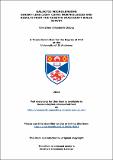Files in this item
Galactic microlensing : binary-lens light curve morphologies and results from the Rosetta spacecraft bulge survey
Item metadata
| dc.contributor.advisor | Dominik, Martin | |
| dc.contributor.author | Liebig, Christine Elisabeth | |
| dc.coverage.spatial | 141 | en_US |
| dc.date.accessioned | 2014-06-17T14:35:27Z | |
| dc.date.available | 2014-06-17T14:35:27Z | |
| dc.date.issued | 2014-06-25 | |
| dc.identifier | uk.bl.ethos.605826 | |
| dc.identifier.uri | https://hdl.handle.net/10023/4881 | |
| dc.description.abstract | For 20 years now, gravitational microlensing observations towards the Galactic bulge have provided us with a wealth of information about the stellar and planetary content of our Galaxy, which is inaccessible via other current methods. This thesis summarises work on two research topics that arose in the context of exoplanetary microlensing, but we take a step back and consider ways of increasing our understanding of more fundamental phenomena: firstly, stellar microlenses in our Galaxy that were stereoscopically observed and, secondly, the morphological variety of binary-lens light curves. In autumn 2008, the ESA Rosetta spacecraft surveyed the Galactic bulge for microlensing events. With a baseline of ∼1.6 AU between the spacecraft and ground observations, significant parallax effects can be expected. We develop a photometry pipeline to deal with a severely undersampled point spread function in the crowded fields of the Galactic bulge, making use of complementary ground observations. Comparison of Rosetta and OGLE light curves provides the microlens parallax π[subscript{E}] , which constrains the mass and distance of the observed lenses. The lens mass could be fully determined if future proper motion measurements were obtained, whereas the lens distance additionally requires the determination of the source distance. In the second project, we present a detailed study of microlensing light curve morphologies. We provide a complete morphological classification for the case of the equal-mass binary lens, which makes use of the realisation that any microlensing peak can be categorised as one of only four types: cusp-grazing, cusp-crossing, fold-crossing or fold-grazing. As a means for this classification, we develop a caustic feature notation, which can be universally applied to binary lens caustics. Ultimately, this study aims to refine light curve modelling approaches by providing an optimal choice of initial parameter sets, while ensuring complete coverage of the relevant parameter space. | en_US |
| dc.language.iso | en | en_US |
| dc.publisher | University of St Andrews | |
| dc.rights | Creative Commons Attribution-NonCommercial-ShareAlike 4.0 International | |
| dc.rights.uri | http://creativecommons.org/licenses/by-nc-sa/4.0/ | |
| dc.subject | Astronomy | en_US |
| dc.subject | Astrophysics | en_US |
| dc.subject | Gravitational lensing | en_US |
| dc.subject | Galactic microlensing | en_US |
| dc.subject | Photometry | en_US |
| dc.subject | Data analysis | en_US |
| dc.subject | Theory | en_US |
| dc.subject.lcc | QB857.5G7L5 | |
| dc.subject.lcsh | Microlensing (Astrophysics) | en_US |
| dc.subject.lcsh | Astronomical photometry | en_US |
| dc.title | Galactic microlensing : binary-lens light curve morphologies and results from the Rosetta spacecraft bulge survey | en_US |
| dc.type | Thesis | en_US |
| dc.type.qualificationlevel | Doctoral | en_US |
| dc.type.qualificationname | PhD Doctor of Philosophy | en_US |
| dc.publisher.institution | The University of St Andrews | en_US |
| dc.publisher.department | School of Physics & Astronomy | en_US |
This item appears in the following Collection(s)
Except where otherwise noted within the work, this item's licence for re-use is described as Creative Commons Attribution-NonCommercial-ShareAlike 4.0 International
Items in the St Andrews Research Repository are protected by copyright, with all rights reserved, unless otherwise indicated.


